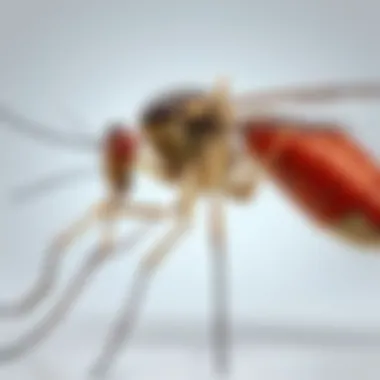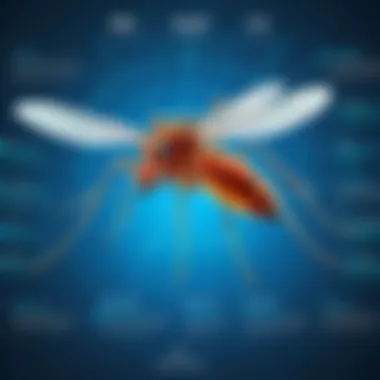Effective Strategies to Combat Mosquitoes: A Comprehensive Guide


Intro
Mosquitoes are more than just pesky insects; they pose significant health risks worldwide. Understanding the dynamics of mosquitoes, from their breeding habits to effective control strategies, is crucial. This discussion highlights various approaches that overlap practical solutions, modern technologies, and ecological considerations. As we unravel the complexities of mosquito management, we will explore how knowledge can empower efforts against these persistent pests.
Technology Insights
Latest Tech Trends
Advanced technology plays a pivotal role in the effort to combat mosquitoes. Techniques such as drone surveillance allow for precise mapping of breeding sites. Innovations include sensors that detect mosquito population densities, which aid in timely interventions. Integrating systems powered by artificial intelligence can analyze patterns and predict outbreaks of mosquito-borne diseases. Such data-driven techniques incentivize effective use of resources in population control.
Innovation in Tech
Innovative solutions are emerging every year. For instance, genetically modified mosquitoes have been engineered to reduce wild mosquito populations. These modifications result in offspring that cannot reach maturity or reproduce. Another technological advancement is the development of non-toxic larvicides that target mosquito larvae without harming other organisms. Lastly, apps that provide real-time weather and biological data equip communities with the information they need to prevent breeding.
Product Reviews
Products designed to repel or kill mosquitoes often combine efficacy with user considerations. One relevant example is the Thermacell Portable Repeller. This device offers a scent-free zone, emitting heat-activated repellent. Users generally find it effective for outdoor activities. Further, mosquito traps, like those produced by Dynatrap, promise to attract and trap mosquitoes using UV light. Each product's utility varies, hence individual research is essential to select the most suitable solution for specific needs.
“Staying informed with the latest technology advancements can significantly improve the effectiveness of our mosquito control measures.”
Sustainable Practices
Sustainable practices are critical in long-term mosquito management. Using biological controls, such as introducing fish that eat larvae or bacteria to impede their growth, reduces reliance on chemicals. Maintaining water bodies clear of debris diminishes breeding sites naturally. Encouraging community awareness on sustainability reinforces the effectiveness of these programs.
For effective mosquito management, combining traditional strategies with modern technology can lead to a robust defense against these insects. By investing in innovation, communities can not only protect human health but also create balanced ecosystems free from the burdens of mosquito-borne diseases.
Understanding Mosquito Biology
Understanding mosquito biology is essential to create effective strategies to combat these pests. Knowledge of their life cycle, the common species, and behavioral patterns is critical in developing comprehensive approaches. Each of these components contributes to our understanding of how mosquitoes thrive and how we can counter them.
Life Cycle
The mosquito life cycle comprises four distinct stages: egg, larva, pupa, and adult. Each stage plays a role in the population growth and control methods.
Egg Stage
The egg stage is the initial phase of the mosquito life cycle. Female mosquitoes lay eggs in stagnant water environments. This specificity is crucial for their survival and contributes greatly to their population density. The eggs can survive in desiccated state for several months, making them resilient. Recognizing the adaptability of mosquito eggs emphasizes the need for targeted prevention strategies. Essentially, eliminating standing water is pivotal.
Larval Stage
The next phase is the larval stage, which emerges after hatching from the eggs. Larvae are aquatic and begin consuming organic matter in the water. The key characteristic of this stage is the presence of primitive respiratory siphons. This feature enables larvae to breathe while submerged often near the water's surface. The importance of larval management cannot be overstated, as effective interventions at this stage can drastically reduce future populations.
Pupal Stage
Following the larval stage is the pupal stage. Unlike larvae, pupae do not eat but are active swimmers. This stage is a transformative period where mosquitoes develop into adults. The unique feature here is their duration spent in water, which confirms the significance of water management. Disruption at this stage offers opportunities for control. It's easier to impact a developing population before they become mature.
Adult Stage
Finally, the adult stage marked by mature mosquitoes ready to mate and search for blood hosts. The characteristics of adult mosquitoes vary between sexes, where only females feed on blood. They possess specialized mouthparts for piercing skin. This trait is critical to understanding their role in disease transmission. In adult mosquitoes, targeting their activity and resting habits can significantly bolster combat strategies.
Common Species
Focusing on common mosquito species helps identify which ones present greater threats.
Aedes
The Aedes genus is known for its role in transmitting diseases like dengue and Zika virus. This species often breeds in artificial containers. Its adaptability to urban environments makes them a serious public health concern. Noted by their striking black and white coloration, they stand out easily in environments where they thrive. To control Aedes populations, urban habitats must be carefully managed.
Anopheles
The Anopheles mosquitoes lead the way in malaria transmission. A distinct characteristic is their behavior of resting at an angle on walls. This species lays its eggs in clean water sources. Efficient screening and treatment methods can mitigate risks but often require coordinated public health initiatives to manage.: .extra.
Culex
Culex mosquitoes are noteworthy for their ability to transmit West Nile Virus. They prefer polluted standing water, which can be problematic in highly urbanized areas. Featuring a more subdued appearance than Aedes, the identification may rely on habitat and behavior. Proper waste management reduces the habitats of Culex mosquitoes effectively and disability.
Behavioral Patterns
Behavioral patterns dictate how mosquitoes function and interact with their environments. Understanding these patterns is integral for control measures.


Feeding Habits
Mosquitoes generally feed during dawn or dusk. Noting their feeding habits can help coordinate prevention methods for maximum effect. Female mosquitoes are attracted to carbon dioxide and various body odors during feeding times. Understanding each species' timelines can lead to better insecticide deployments.
Breeding Preferences
Diverse breeding preferences among species elucidate adaptation to various environmental conditions. *Aedes penalizes clean water environments, whereas Culex thrives in polluted areas. Knowledge of their breeding preferences aids in water management efforts to remove or treat breeding sites.
Activity Levels
Mosquitoes exhibit varying activity levels based on time and environmental factors. Preferential feeding and mating times provide insights needed for monitoring. Targeting specific active phases offers avenues for strategic interventions. Knowing which environmental instances illicit increased activity can center strategies and approach tailored responses.
Disease Transmission
Mosquito-Borne Diseases Overview
Malaria
Malaria remains one of the most prevalent mosquito-borne diseases, especially in tropical regions. The Parasite Plasmodium is responsible for this disease, which is transmitted primarily through the bites of infected Anopheles mosquitoes. Over the years, malaria's impact on public health has underscored the need for effective control strategies, such as insecticide-treated bed nets and antimalarial medications. A unique feature of malaria is its cyclical nature, exacerbated by environmental conditions. This characteristic could present challenges, demanding ongoing surveillance and adaptive management solutions.
Dengue Fever
Dengue fever is another significant concern globally. It represents the most rapidly spreading mosquito-borne viral disease. The Aedes aegypti and Aedes albopictus mosquitoes transmit this illness. Symptoms can be severe, ranging from flu-like effects to life-threatening complications. Its resilience makes it a key subject for our discussion. This unique characteristic compels public health officials to deploy diverse strategies, from vaccination to community awareness. The economic burden of the disease poses additional challenges, highlighting the importance of continued innovation in prevention.
Zika Virus
Zika virus, initially a rare occurrence, has garnered significant attention due to its links to severe birth defects in infants born to infected mothers. Transmitted mainly by Aedes mosquitoes, Zika's global spread warrants close observation. Factors making Zika particularly noteworthy include its recent emergence in various regions and the associated societal implications. Understanding Zika contributes important facets to mosquito combat strategies, especially resonating in terms of public health communication.
Impact on Public Health
Statistics and Trends
Analyzing statistics and trends provides an objective lens to witness the rising impact of mosquito-borne diseases. The World Health Organization regularly publishes new data indicating the expanding geographical spread of diseases like malaria, dengue, and Zika. This capacity for rapid transmission reinforces a need for urgent preventive measures. The unique characteristic here is the adaptability of these mosquitoes to changing environments, leading to new high-risk areas.
Risk Factors
Identifying risk factors associated with mosquito infestations can guide prevention efforts. Urbanization, climate change, and changes in land use environment notably increase mosquito population dynamics. Areas with poor drainage and waste management often face steeper disease transmission rates. It is crucial to focus on how modifying these risk factors can serve as impactful preventive measures while redirecting public health efforts more effectively.
Preventive Measures
Preventive measures remain crucial to tackle mosquito-borne diseases comprehensively. Integrated control strategies—combining personal protection, community efforts, and environmental management—hold promise. Such multifaceted approaches help in reducing the prevalence of the mosquitoes in contexts where outbreaks are more likely. A clear focus was laid on community involvement, incentivizing public campaigns on bolstering awareness. Overall, understanding preventative methodologies provides invaluable insights, aiding efficient interventions amidst overwhelming challenges.
Preventive Strategies
Preventing mosquito bites and limiting their populations is crucial to reducing the risks of mosquito-borne diseases. The highlighted strategies in this section serve as effective ways to address mosquitoes, both at the individual level and broader community scale. Realizing the importance of preventive strategies can be a game changer in health management and environmental sustainability.
Personal Protection
Use of Repellents
Repellents are essential tools for personal protection against mosquito bites. They contain specific active ingredients that effectively deter mosquitoes. DEET, picaridin, oil of lemon eucalyptus, and IR3535 are the key substances found in these products.
The uniqueness of repellents lies in their ability to create an invisible barrier on the skin, thus preventing mosquito attachment and biting. The main benefit of using repellents is their immediate effect; once applied, a person can enjoy outdoor activities with reduced risk.
However, there are some considerations. Certain repellents may irritate the skin or have a strong odor. It's essential to choose the repellent that works best for you and follow the instructions carefully.
Protective Clothing
Utilizing protective clothing is critical in safeguarding against mosquitoes. Clothing made of lightweight, long-sleeved shirts and long pants decreases the skin exposure and creates a physical barrier against bites. Fabrics that are tightly woven make it harder for mosquitoes to penetrate.
An advantage of protective clothing is that it does not require regular reapplication like repellents. Additionally, clothing treated with permethrin can offer extended protection. On the downside, adapting this form of protection can sometimes lead to discomfort, particularly in hot weather, as it may increase sweating.
Physical Barriers
Physical barriers consist of nets and screens that prevent mosquitoes from entering a living space. These barriers are crucial in regions where mosquito activity is high or during certain seasons when mosquito populations significantly increase.
A key characteristic of physical barriers is their permanence; installing screens on windows and doors can provide long-term protection. Automatically fitted mosquito nets can protect players not only indoors but also during outdoor gatherings. However, they require maintenance to ensure their integrity and effectiveness against frequent breaches by pests.
Environmental Management


Removing Standing Water
Eliminating standing water is essential in reducing mosquito breeding locations. This could involve regular inspections around one’s property to remove water from buckets, bird baths, and clogged gutters. Mosquitoes lay eggs in standing water, making this step pivotal in any preventive strategy.
A notable feature of removing standing water is its direct impact on reproduction rates of mosquitoes. Periodic maintenance can significantly disrupt the life cycle of mosquitoes within a localized area, thus keeping their population in check. However, diligence is required to ensure no water accumulates over time, which can be labor-intensive.
Landscaping Techniques
Effective landscaping can play a major role in mosquito management. This includes planting mosquito-repelling plants such as lavender, marigolds, or citronella near outdoor living areas. Tall grass, dense bushes, and overgrown landscapes create ideal shelter for adult mosquitoes.
Landscaping techniques allow individuals to control various aspects of their immediate environment. A significant advantage is the potential to enhance outdoor aesthetics while simultaneously reducing mosquito habitats. However, this can incur additional upkeep to manage the third-party plants intended for mosquito deterrence.
Water Treatment
Water treatment refers to techniques employed to make water less conducive for mosquito breeding. This includes methods like introducing biocontrol agents that target mosquito larvae and ensuring chemical treatments can be applied effectively in treatment facilities.
A critical feature of water treatment is that it targets the larvae even before they become adult mosquitoes, thus interrupting their lifecycle at crucial stages. While this method shows great potential, careful application is necessary to mitigate potential negative environmental impacts from chemicals.
Effective mosquito management requires combined efforts from personal protection to environmental management. Adopting these strategies provides a holistic approach to mitigate the challenges posed by mosquitoes.
Control Methods
Control methods are essential in the fight against mosquitoes. These methods seek to reduce mosquito populations and minimizes potential disease transmission. Effective control strategies contribute to areas like public health and ecological balance. The balance is critical, as tactics should not harm other beneficial insects or the environment.
Chemical Control
Chemical control involves the use of various agents designed to incapacitate mosquitoes. This form can provide immediate effects and is often users favored for its rapid action.
Insecticides
Insecticides are among the most common chemicals used in mosquito control. They target adult mosquitoes primarily, hastening their elimination from the environment.
- The key characteristic of insecticides is their rapid action against resistance strains of mosquitoes. This addresses the increasing prevalence of populations resistant in certain regions.
- A beneficial choice outlined in this article, insecticides can be easily applied. Methods include sprays and fogs, suitable for large area treatment.
- These agents offer unique features in terms of efficacy, but they also come with disadvantages. Overuse or improper application can lead to resistance build-up which reduces effectiveness.
Larvicides
Larvicides are a distinctive type aimed at the immature stages of the mosquito lifecycle. They play a vital role in environmental management.
- The key characteristic of larvicides is their specific targeting of larvae during their fragile developmental stages, disrupting growth before adulthood.n
- A popular choice due to its targeting precision, larvicides can drastically reduce future populations when effectively applied in standing water.
- A unique feature is their selective action. However, they can hamper beneficial larvae populations in ecosystems if used irresponsibly.
Residual Spraying
Residual spraying involves applying insecticides to surfaces where mosquitoes may land. This method can stabilize the effectiveness of treatments and maintain suppression of mosquito populations.
- The key characteristic is durability. Insecticides applied can remain active on treated surfaces for extended periods.
- Considered beneficial for areas with high-transmission rates, it establishes prolonged protection.
- A unique feature is the low frequency of applications needed, but potential health risks can be a concern due to exposure for residents or pets nearby.
Biological Control
Biological control employs natural predators or microorganisms to manage mosquito populations. This method emphasizes sustainability and environmental impact while fighting against mosquitoes.
Predatory Fish
Predatory fish, such as gambusia, are viable allies against mosquitos. They consume larvae in water and can significantly reduce future adult populations.
- A key characteristic of these fish is their opportunistic feeding behavior, so they can control larval population efficiently with minimal competition.
- Predatory fish are a beneficial choice due their complimentary role in ecosystems without harsh effects.
- A unique feature is their ability to reproduce quickly in suitable environments yet their introduction can have risks if localized ecosystems are disrupted.
Bacterial Insecticides
Bacterial insecticides leverage specific bacteria strains that target mosquito larvae with lethal effects while leaving non-target species unharmed.
- A pivotal feature is their specificity, causing no harm to beneficial insect populations.
- Especially popular in sustainable pest management programs, they help regulate populations effectively after being introduced.
- However, disadvantages might include short life-span and limited application seasons, reducing efficiency overall.
Genetic Control
Genetic control techniques seek to reduce mosquito populations by modifying their genetic makeup. This can happen through various approaches, including gene drives that ensure particular genes spread in wild populations.
- A defining characteristic is the novelty of utilizing advanced biotechnology for control measures.
- This is an upcoming yet beneficial choice, especially as risks from conventional methods of insecticides and environmental impact are more known now.
- Advantages are its theoretical impact on mosquito populations, however ethical considerations and ecological uncertainties closely accompany these techniques.
In summary, each method has its own benefits and immediacy to apply vary, yet understanding their particular strengths is crucial for long-term management of mosquitoes.


Innovative Strategies
Innovative strategies in mosquito control play a critical role in enhancing the effectiveness of both current and future mosquito management practices. As the challenges associated with mosquito populations evolve, so too must our approaches. These innovations leverage emerging technologies and genetic advancements, aiming for results that not only combat mosquitoes but also minimize risks to human health and the environment.
Genetically Modified Mosquitoes
Overview of Technology
Genetically modified mosquitoes (GMMs) are an intriguing development in vector control. This technology involves altering the genomes of mosquitoes to manipulate their reproductive capacity or increase their susceptibility to diseases. The modifications can make them less likely to transmit diseases or reduce their population.
One key characteristic of GMMs is the use of a technology called CRISPR. It allows for precisely targeted genetic edits—an innovative and powerful method, making GMMs a popular choice in discussions on combating mosquitoes. The unique feature of this technology lies in eradicating mosquito populations without the extensive use of chemicals. Its advantage is the potential for sustainable control without prompting resistance in mosquito species.
Potential Risks and Benefits
Before deploying GMMs, it is essential to discuss the potential risks and benefits associated with their use. On one hand, the benefits include a significant reduction in disease transmission rates and less reliance on chemical pesticides. GMMs can reduce the environmental impact traditionally associated with control measures.
On the other hand, there are risks to consider. Such alterations might unintentionally affect broader ecosystems, including non-target species. Moreover, public acceptance and regulatory approval remain crucial challenges. Assessing unique features of these benefits versus risks aids in considerations about their introduction in various environments.
Case Studies
Examining case studies not only provides valuable insights into GMM effectiveness but also showcases successful or unsuccessful implementations. Recent projects in Brazil and India demonstrate how GMM initiatives have influenced local mosquito populations.
These case studies identify the key characteristic: successful population reduction without harming surrounding environments or increasing disease incidences. However, the unique downside appears when community reactions vary, affecting progress. These instances underscore the complexities involved in introducing genetically modified organisms to natural habitats.
Smart Technology Applications
Internet of Things (IoT) Solutions
IoT solutions provide cutting-edge applications valuable for mosquito management. Through connected devices, researchers can track environmental conditions and mosquito populations in real-time. This data aids in strategic decision-making.
A strong point of IoT systems is their ability to integrate various data sources into cohesive insights. They can identify mosquito breeding hotspots much more effectively. This kind of technology stands out due to its scalable nature across communities while offering precise information for educated actions against mosquitos.
Automated Traps
Automated traps mark innovation trifecta as they not only capture mosquitoes but also analyze patterns in mosquito behavior. These traps utilize sensors and cameras to lure and monitor mosquito populations. Their data contributes to refining control strategies.
The significance is largely driven by the efficiency of automated traps. They eliminate manual labor, offering a continuous method of monitoring or capturing mosquitoes. However, there is a downside involving the upfront cost and maintenance of integrating such advanced technology in different settings.
Data Analytics for Predictions
Data analytics enhances the predictive abilities essential for mosquito control. By processing historical data and environmental variables, it becomes possible to forecast mosquito population trends. This means managers can prepare in advance, rather than merely react.
A vital feature of data analytics lies in its extensive capability to correlate various influencing factors. This results in smarter resource allocation for control efforts. Its unique feature provides actionable insights; yet, there's the risk of misinterpreting data trends if not contextualized correctly.
The implementation of innovative strategies requires precise consideration on adaptation to local contexts and regulations.
Public Policy and Education
Public policy and education play a crucial role in addressing the ongoing challenges posed by mosquitoes. Fostering a well-informed community shapes effective mosquito management strategies. Such involvement creates a safer environment and diminishes the spread of mosquito-borne diseases. Through awareness, legislation, and education, communities can tackle these pests more effectively.
Community Awareness Programs
Educational Campaigns
Educational campaigns are essential for raising awareness about mosquito control. They inform residents about the risks associated with mosquito-borne diseases and the preventive measures that individuals can take. An important characteristic of such campaigns is their focus on practical strategies. This aspect is beneficial as it empowers individuals to engage in community initiatives. A unique feature of educational campaigns is their use of local testimonies and visual aids. This method grabs attention and demonstrates the effectiveness of preventive tactics. One downside can be sustaining engagement after the initial push for awareness ends.
Community Involvement
Community involvement greatly enhances mosquito management efforts. When local residents take part, it creates a sense of ownership concerning their environment. This is a valuable aspect of involving communities in tackling mosquitoes. Communities can organize clean-up drives and initiate regular monitoring of common breeding sites. Interestingly, youths often take the lead in renaissance efforts by using social media. Engaging through digital communication can strengthen connections. However, coordinator fatigue may serve as a challenge, overwhelming organizers over time.
Collaboration with Health Organizations
Collaboration with health organizations fosters knowledge sharing and resource allocation. These partnerships are vital because health agencies have the expertise needed to confront mosquito issues. Through these partnerships, community programs benefit from health campaigns refined by research-based insights. Groups such as the World Health Organization or local health departments can track trends and advise on best practices. A significant consideration is that such collaborations can sometimes complicate logistics for community leaders, causing delays in implementation.
Legislation and Regulations
Local Ordinances
Local ordinances are necessary to regulate and restrict conditions favorable to mosquitoes. Families and businesses are often subject to these regulations. They play a unique role by determining what measures can be enforced in specific areas. Compliance with ordinances may produce immediate changes, fostering a safer environment. However, enforcement challenges can energize local resistance.
National Policies
National policies set baseline standards for mosquito control across regions. They address broader public health priorities and allocate resources decently. This characteristic can promote effective inter-regional cooperation, leading to a more cohesive approach to mosquito control. The drawback can be perceived disconnect when policies do not fully consider regional differences, which can warp their applicability in practice.
International Cooperation
International cooperation is essential in addressing mosquito-related issues that cross borders. By collaborating with multiple countries, this approach enables effective information exchange and jointly developed strategies. It creates strength in numbers, fostering global research initiatives and resource allocation. However, diverse regulatory frameworks may complicate coordination and effectuate decision delays.







